|
Every Masonic researcher must have
encountered illustrations of masons' marks at some time in his career. These
illustrations abound in early volumes of Ars Quatuor Coronatorum and the
Transactions of several other lodges of research, and in certain
non-Masonic publications as early as 1843. Unfortunately, much of the published
material reveals a lack of scientific method in observation and recording of
data, and there is no definitive study of the subject as a whole. Worse — some
authors attempt to link masons' marks with occult religion, numerology, alchemy,
the genesis of alphabets and other imaginative theories which blithely ignore
sites and ages that do not fit their needs.
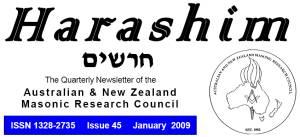 ANZMRC publishes a quarterly newsletter, Harashim (Hebrew for Craftsmen), which is circulated worldwide in PDF format by email.
Subscribe Harashim.
ANZMRC publishes a quarterly newsletter, Harashim (Hebrew for Craftsmen), which is circulated worldwide in PDF format by email.
Subscribe Harashim.
|
Bro Robert Gould's History of
Freemasonry provides a sound beginning to the study of the subject but, as a
summary of what has been published elsewhere, it necessarily reflects the
limitations of its sources. It is interesting, however, to compare Bro Gould's
essay in the first edition (vol 1, ch 9) with Bro Herbert Poole's revision in
the third edition (vol 1, ch 7), revealing the advance in knowledge in the
intervening period and contrasting the attitudes of these two great researchers.
Masons' marks have been found throughout
the northern hemisphere, and range over a timespan of nearly 5000 years.
It is very remarkable indeed that these
marks are to be found in all countries — in the passages of the pyramids; on the
underground walls of Jerusalem; in Herculaneum and Pompeii; on Roman walls and
Grecian temples; in Hindustan, Mexico, Peru, Asia Minor, — as well as on the
great ruins of England, France, Germany, Scotland, Spain, Italy and Portugal.[1]
Since we in Australia lack the
opportunity to examine the original marks on ancient stones (apart from those
made by our aboriginal inhabitants), we are obliged to limit our studies to the
secondary sources available to us. Within this limitation, this paper will
briefly consider marks found throughout the northern hemisphere on structures
erected over a period of 5000 years. It will refer to a selection of sites, for
the most part in chronological sequence, illustrating some of the marks and
noting (where such information is available) their position on the stones and
the frequency of their use. From the data thus recorded, this paper will
consider the functions of these marks. Because of the limitation of time, only
passing reference will be made to the symbolism of some marks, and the
speculative degrees that make use of masons' marks.
Egypt
Brother Hayter Lewis, in his paper
‘Masonry and Masons’ Marks’,[2]
says:
The earliest marks now known to exist
are those found by Col. Vyse in the Chambers of the Great Pyramid at Gizeh. I
quite acquiesce in the opinion of the late Dr. Birch that these are not strictly
Masons' but quarry marks. But some of them require especial notice
inasmuch as they continue in use, as Masons' Marks, through all the centuries
down to mediaeval times — and many even to the present.
He goes on to refer to one of these
marks as ‘the Greek P’, but does not illustrate it; we are left in some doubt
whether he is refering to pi or rho. Commenting on this paper, Bro
William Simpson states that these marks were not incised, but were made with red
paint.[3]
Professor Flinders Petrie (a grandson of
Matthew Flinders) records a number of incised marks of the 12th dynasty (c
2500 bc),[4]
including the following:

Jerusalem
One of the most interesting sites for
us, as speculatives, is that of the Haram area of Jerusalem. This includes the
site of the Temple, virtually closed to excavation for religious reasons. In the
1860s three young officers of the British army, Charles Wilson, Charles Warren
and C R Conder, were seconded successively to the Palestine Exploration Fund.
Wilson is later referred to as Colonel Sir Charles Wilson, and Conder as Colonel
Conder. Warren was already a Mason at the time of his secondment, and was to
become Major General Sir Charles Warren,
gcmg, kcb, the foundation Master of Quatuor Coronati Lodge, and
Commissioner of Police for the Metropolis at the time of the Jack the Ripper
murders.
Josephus, writing in the first century
ad, gave a description of the
great height of the walls of Jerusalem, which appeared to 19th century
archaeologists to be a gross exaggeration. Bro Warren reasoned that the repeated
destruction of the city would have caused the valley to fill. He decided to
excavate on the outer side of the wall surrounding the Haram as Sharif, or Noble
Sanctuary. He sank a shaft at the southeast corner, where the wall rose 77 feet
6 inches above ground level. He discovered the foundations 80 feet below, on
bedrock: a tall wall indeed.
Some massive and uneven stones were used
in the construction of this wall. Barclay's Gate, on the western side, near the
Wailing Wall, boasts a lintel from 20 to 24 feet long and 6 feet 10 inches wide.
On the south wall is a stone estimated to weigh 100 tons.[5]
Bro Warren found a broken stone that had spanned Robinson's Arch, 42 feet wide,
on the western side of the Haram Wall, near the southwest corner.[6]
At the excavation at the southeast
corner there were mostly smaller, hewn stones, and the base of the wall rested
on rock cut to receive the foundation stones. Here were Masons' marks. Some were
incised, about 3/8ths of an inch deep, and others were painted red — like the
marks in the chambers of the Great Pyramid. There were splashes of the same
colour paint on the bedrock.[7]
As historical researchers, we would be unwise to read too much into this
particular link across the miles and the millenia.
These marks were viewed by two notable
visitors, Dr Emanuel Deutsch and Bro William Simpson (who became the third
Master of Quatuor Coronati Lodge). Later, the excavations were filled in,
presumably because of danger to locals and tourists, and Bro Prof T Hayter Lewis
(7th Master of QC) was unable to view these marks when he visited Jerusalem.
The painted marks were on the second and
fifth courses of stones, and consisted mostly of curved characters resembling
e, j, Q and u, but also with marks similar to T,
X and Y. Curiously, one stone of the fifth course and one of the
second had at least 7 marks each. The incised marks were angular but not
clean-cut, mainly crosses and squared U-shapes. They are illustrated in (1889)
AQC II at page 125. Dr Deutsch declared the marks to be Phoenician
letters and numbers.[8]
C R Conder considered them ancient Hebrew characters, in use up to the time of
Herod.[9]
Prof R A S Macalister conceded that some of the marks resembled
Phoenician or Old Hebrew characters, but suggested that they were ‘probably mere
graffiti with no special significance’.[10]
Bro J F Finlayson went further and argued that they were totally unlike
Phoenician script.[11]
Identification of the marks is important
in determining the age of the lower courses of the Haram Wall. Bro Warren,
following Deutsch, placed it in King Solomon's reign, probably constructed by
the same craftsmen who built the Temple. Brothers Gould and Lewis tended to
concur, but Bro Simpson was more cautious. Wilson took the view that the
foundation stones were second-hand, brought from elsewhere, and placed in their
present position in Nehemiah's time (c 457
bc), while Conder ascribed the construction to Herod the Great (c
20 bc).
As Bro Simpson remarked:[12]
No one supposes that they are later than
Herod's time, and that gives a very respectable antiquity to these masons'
marks.
 Bro Warren also recorded masons' marks in Lebanon and Syria,[13] but without indication of date of origin. Among those at Baalbek were: Bro Warren also recorded masons' marks in Lebanon and Syria,[13] but without indication of date of origin. Among those at Baalbek were:
 and at Damascus: and at Damascus:
The many marks on castle walls at the
ancient Phoenician port of Sidon included:
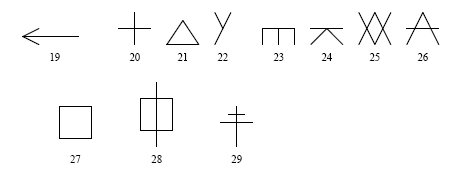
Further East
Generally, the snippets of information
available about marks observed in the East do not include date of origin. Those
referred to hereafter in this paper are clearly less than 2000 years old.
Bro Harry Rylands (6th Master of QC)
provides information supplied by W F Ainsworth[14]
on marks in the ruined palace at Al-Hadhr (ancient Hatra) in Iraq. Ainsworth
observed a single mark in the centre of the exposed face of each stone,
generally one or two inches in size. He remarked:
Every stone, not only in the chief
building, but in the walls and bastions and other public monuments, when not
defaced by time, is marked with a character, which is for the most part either a
Chaldaic (Khaldi) letter or numeral.
He noted several instances of a
character similar to the Roman A and frequent use of the ‘ancient mirror
and handle’ — a circle above an inverse T. Among the signs he and Esau
Rassam recorded were

Bro Gould illustrates four marks
observed by Selah Merrill[15]
at ‘the Mosque and Reservoir at Bozrah’ — presumably Al-Basrah, in Iraq. Each of
these marks was restricted to a single wall, but appeared on many of the stones
on that wall. Many stones, however, had no mark.
In the discussion of Bro Lewis' paper,
Bro Simpson remarked[16]
that in northern Persia (Iran):
… sun-dried bricks, or mud, was the
building material, and in important structures the walls were covered with
coloured tiles. All that remains of a deserted city in that region are mounds,
and Masons' Marks are out of the question. Bro Purdon Clarke should be able to
tell us if such marks are to be found any where in Persia.
Bro Sir Caspar Purdon Clarke (13th
Master of QC) responded:[17]
… I only noted two extensive series of
markings, one at Besitoon, … the other at Ispahan … At Besitoon the marks
occurred on a single course of Ashlar facing of the plinth of the brick built
Caravanserai of Shah Abbas. The stones were about 18 inches high by 2 feet long,
and were most probably not more than 5 inches thick. Each bore a mark about 2
inches high right in the centre and strongly cut in … At Ispahan the marks were
also very numerous, they occurred on almost every stone of the paving of a large
court yard in the old Palace.
Bro Clarke dated both buildings as early
16th century. He noted that several of the 10 or 12 varieties of mark at
Besitoon appeared ‘distinctly European’, whereas none of the 30 or so varieties
at Ispahan bore such a resemblance. Bro Clarke's observations and enquiries
indicated that at both places the stones had been recently turned, the inference
being that the marks had not been on an exposed face, originally.
Bro H J Whymper reported a number of
marks on 16th century buildings in Jaunpore (Jaunpur, northern India),[18]
including:

Two contributors to AQC have
supplied marks from Agra, also in northern India: Bro John Yarker and (Brother ?
Sister ?) H G M Murray-Aynsley. Bro Yarker submitted copies of masons' marks
obtained from the Taj Mahal by Bro Lawrence-Archer, including:

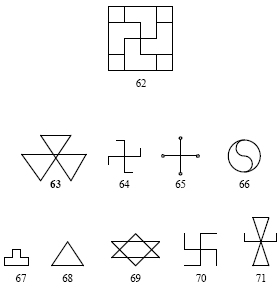 Mrs Harriet Murray-Aynsley, who bore the
unique distinction of being the only associate member of Quatuor Coronati Lodge,
[19]
contributed papers on symbols such as the Tau and the Swastika. On the platform
of the Taj she located (fig.62) a more elaborate version of the 'squared'
swastika of figure 52 (above).
Mrs Harriet Murray-Aynsley, who bore the
unique distinction of being the only associate member of Quatuor Coronati Lodge,
[19]
contributed papers on symbols such as the Tau and the Swastika. On the platform
of the Taj she located (fig.62) a more elaborate version of the 'squared'
swastika of figure 52 (above).
She also noted masons' marks at the Ram
Bagh in Agra,
[20]
including fig. 63-66.
Finally, Bro Yarker presented marks
found on ruined Hindu temples, and among them were the following fig. 67-71
Rome and Pompeii
Under the general heading ‘Rome’, the
Encyclopedia Britannica has an informative entry on masons' marks:
A very curious series of masons' marks
exists on buildings of the regal period, especially on the stones of the agger
wall and those of the small cellae on the Palatine near the Scaelae Caci. They
are deeply incised, usually on the ends of the blocks, and average from 10 to 14
inches in length; some are single letters or monograms; others are numbers; and
some are doubtful signs …
The regal period was 753-509
bc. All the marks included in the
Britannica are reproduced herewith:
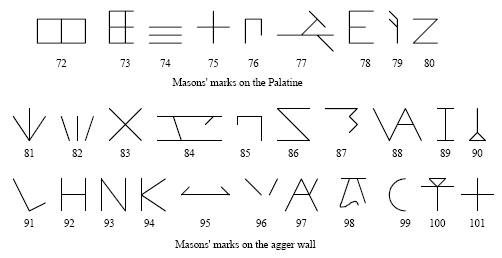
Marks found at Pompeii by Bro Simpson,[21]
include:

Medieval and modern Europe
Examples of masons' marks in Europe
since Roman times are generally dated from late 12th century onwards.[22]
Academic interest in these marks seems to have commenced with the publication of
papers in England by George Godwin frs,
fsa in 1841, V Didron in France in 1845, and by Patrick Chalmers
fsa in relation to Scotland in
1852.[23]
These and subsequent articles, some containing hundreds or even thousands of
marks, were published in the transactions of local or national societies of
architects, antiquaries and archaeologists. To locate and collate all of them
(or even those published in a single country) would be a mammoth task for a
European researcher, and an impossible one for those of us resident in the
antipodes.
Articles and collections of masons'
marks began to be published in Masonic periodicals from 1851 and subsequently
(as already noted) in Ars Quatuor Coronatorum and the Transactions
of other lodges of research. Most of these are deficient in essential details,
and many provide only a small selection of the marks observed. Bro Gould (and,
later, Bro Bernard Jones[24]),
covering the whole subject of Freemasonry, was necessarily restricted to a small
sample in his summary of the subject of masons' marks. Other historians and
encyclopedists offer even smaller samples, or none.
The student outside Europe, therefore,
has access to only a minute proportion of secondary sources, the selection of
which has been made by a number of people (sometimes from primary and sometimes
from secondary sources), based either on unspecified criteria or in support of a
particular theory.
As if this were not difficult enough,
there is the further complication that in the 18th and 19th centuries
speculative degrees and Orders developed which adopted the registration and use
of masons' marks. From the 16th century, and perhaps earlier, Scottish operative
masons were allocated a mark, recorded in the lodge register. Those lodges which
admitted non-operative masons extended the practice to them. When English-style
speculative Masonry became popular in the 18th century, various ‘Mark’ degrees
were developed, including: Mark Mason, Mark Fellow Mason, Mark Master; Ark, Mark
and Link; Link and Chain; Black Mark; Knight of the Christian Mark; Fugitive
Mark; Travelling Mark; Cain's Mark; Mark Man and Old Mark.[25]
The modern Mark degree, whether part of
the Royal Arch (Ireland, Scotland) or of the Craft (Scotland) or as a concordant
body (England), registers a mark to each member. In South Australia it usually
takes the form of a monogram of the candidate's initials. Such monograms would
seldom appear on stone and, in any event, would generally be distinguishable
from operative masons' marks. However, there remains the possibility of
confusion of operative and non-operative sources on stones worked in the 18th
and 19th centuries.
Clearly, the present paper cannot
illustrate all of the relatively small number of marks (i e, thousands,
rather than hundreds of thousands) available to Australian researchers. It would
be advisable, then, to outline the types of data to be sought, and the grounds
for selection of illustrative marks.
The ideal report would indicate the age
and type of building, whether standing, undergoing renovations or in ruins; the
position of the mark on the face of the stone, and whether on an exposed or
(originally) concealed face; the type of mark and the frequency of use of that
mark on the site; the number of marks on a single stone; the proportion of
stones marked, and the significance of marked stones (cornerstone, keystone,
etc).
Such information could reveal the
original purpose of the marks in a particular area during a specified period,
such as a signature (for quality control, payment of piece-work, or simply the
pride of the master craftsman), as instructions for placing the stone in the
intended structure, or for a religious or esoteric purpose. The information
might also indicate the movement of individual masons or groups, the spread of
building knowledge or style, or previously undiscovered links between operative
and speculative masonry.
The English, French, German, Irish and
Scottish marks which follow have been selected for their relevance to one or
more of the points in the previous paragraph, or to illustrate how widely the
mark was used, whether for one of the above purposes or as a symbol.
It should be borne in mind that where
marks of similar design are illustrated, and one is rotated 90 or 180 degrees in
respect to the other, they may in fact be identical. For example:

One further point, before we examine
European marks: the cross may take many forms, some of which predate
Christianity. English heraldry recognises 285 varieties.[26]
Among the following 14 variations are those which appear as marks in this paper:

England and Wales
The earliest certain date for masons'
marks in England is 1119, when a particular part of Norwich Cathedral[27]
was constructed. Some very elaborate marks were found on the arches there, which
suggests that even then a large number of masons had individual marks.
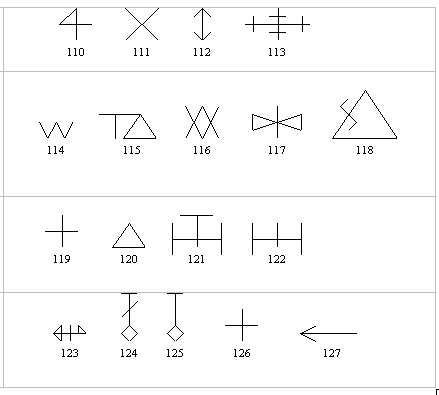
Some of the simpler marks, which also appear on other sites, are fig. 110-113:
Stones removed from the east end
of the choir of Manchester Collegiate Church, erected in mid-15th
century, bore masons' marks, but Bro A Abrahams of Adelaide, who copied
them (fig.114-118), did not indicate on which face they appeared.[28]
At Corbridge-on-Tyne the
following marks were observed ( fig.119-122) by Bro J Witter on a bridge built in 1674:[29]
Of those signs, the triangle appeared most frequently.
He then examined a bridge at
Chollerford, dated 1745, where he found numerous examples of 5 marks
(here illustrated in order of frequency)- Fig. 123-127:
Two brethren reported marks on buildings
under construction, at Truro in 1886[30]
and Newcastle in 1891.[31]
The clerk of works at Truro Cathedral recorded the marks of the masons under his
supervision. The stones were marked on the lower face, and thus the marks were
concealed when the stones were laid. They included:
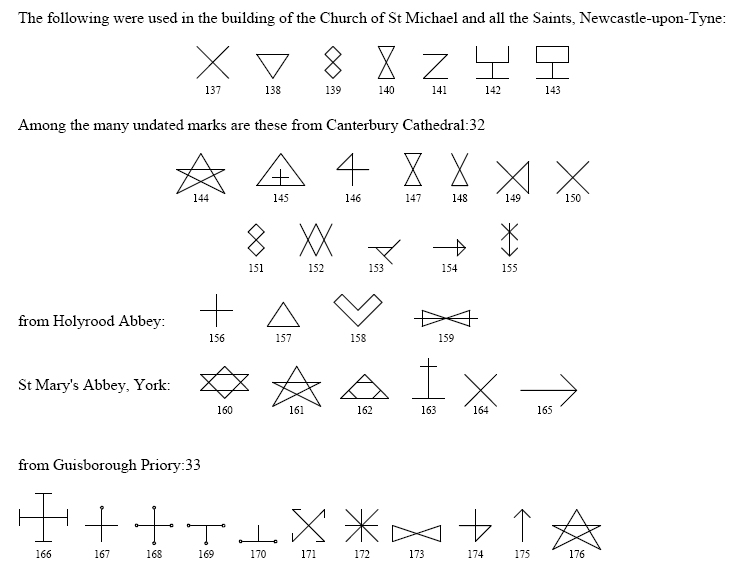
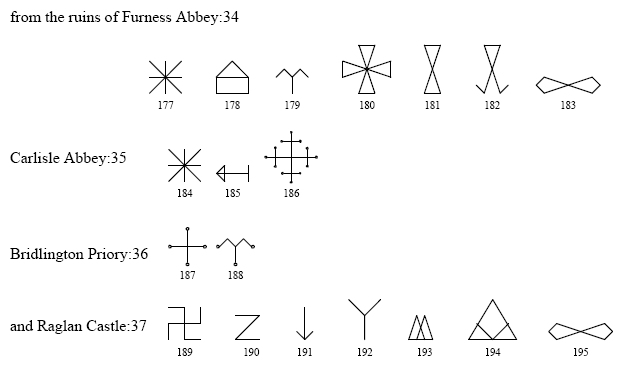
See notes:
[32]
[33]
[34]
[35]
[36]
[37]
Lancashire and Cheshire
Bro Harry Rylands made a special study
of masons' marks in Lancashire and Cheshire, and presented a paper to the
historical society of those counties. Subsequently, the plates from that paper
were published in AQC.[38]
They contain about 1140 marks, collected by several observers, some of whom
noted the location and frequency of the marks and the age of the buildings. From
this large and useful collection, 26 marks have been selected as of particular
interest, appearing at one or more of the 21 sites described in the table,
below.
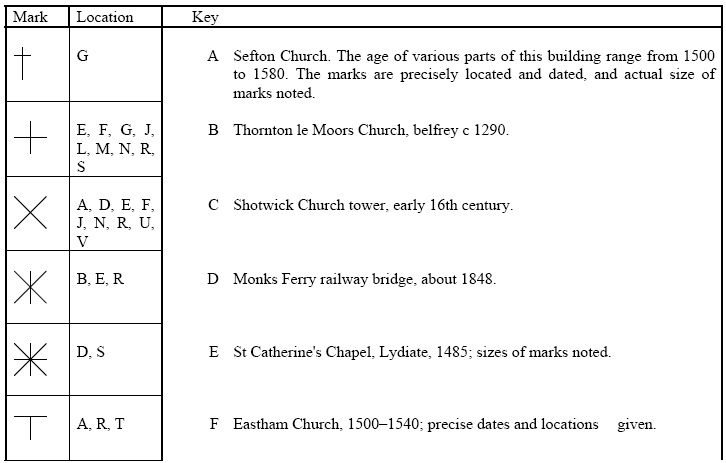
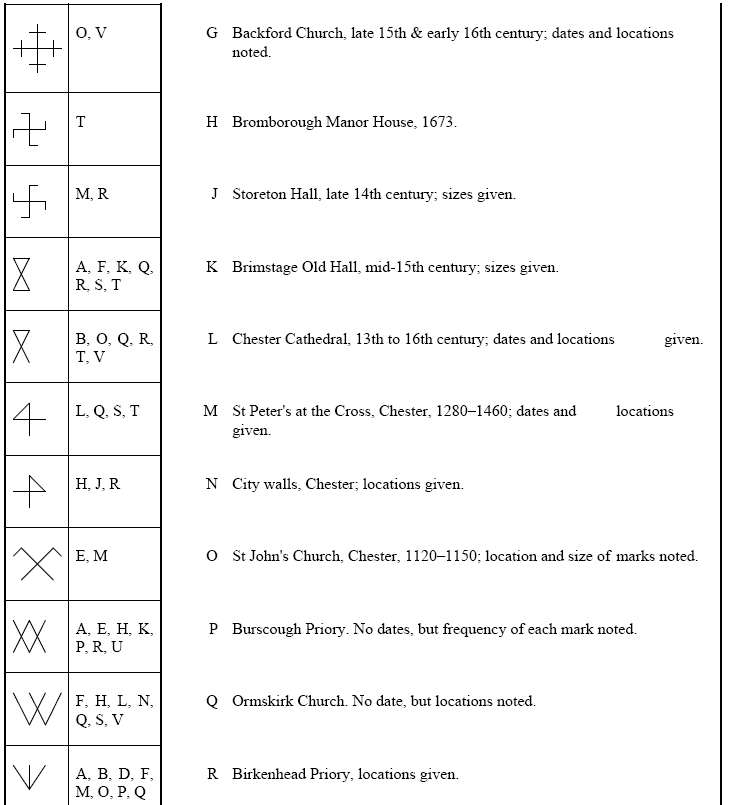
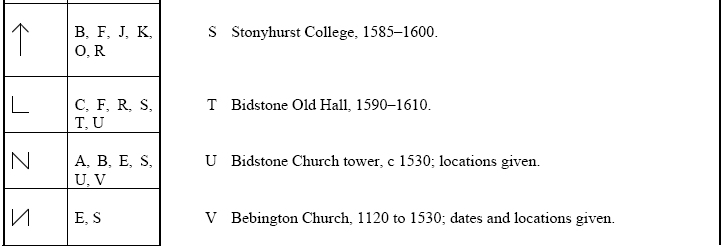
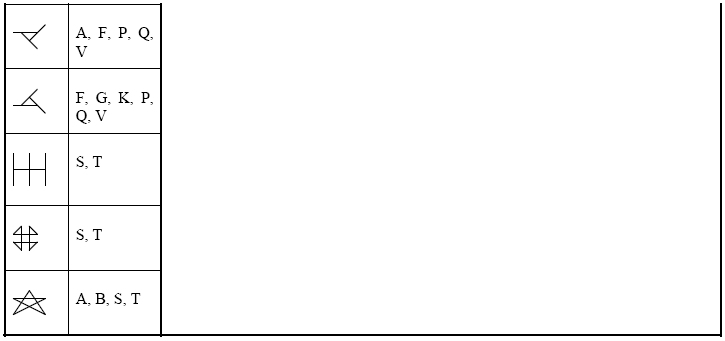
France and Germany
The only marks generally available in
Australia from continental Europe are a few from France and Germany, contained
in Gould's History of Freemasonry. Those of the ‘Chateau of the Popes’ at
Avignon include (below, left):
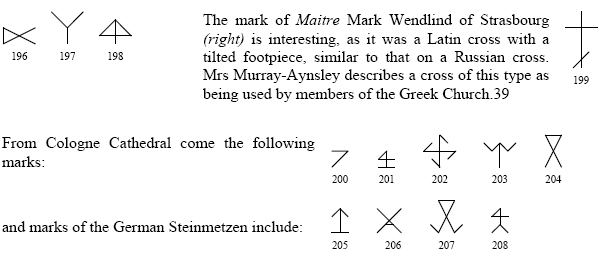
See note: [39]
Ireland and Scotland
The earliest known examples of masons'
marks in Ireland are to be found in the ruins of Grey Abbey, north of
Killyleagh. It was built in 1193 for the Cistercian monks, and the marks are
recorded in Caementaria Hibernica. Bro Chetwode Crawley, clearly of the
Gould-Carr school, has this to say:[40]
… This edifice was built by a company or
Lodge of Freemasons, who had been previously employed on the great Cistercian
monasteries at Whitby and elsewhere in the North of England. They left behind
them on their work the characteristic Masons' Marks, to which we attach so much
importance, because we can safely assume that wherever they occur they were made
by Operative brethren, who were bound by the same ties, and had learned their
lessons in the same way as ourselves; who, in short, belonged to an organisation
which lacked but time and circumstance to develop into the Speculative system of
today. These marks cannot be later than 1210,
A.D., and are, as far as the
present writer knows, the earliest in Ireland to which an incontrovertible date
can be assigned.
Curiously, few of these ‘characteristic’
marks resemble marks found elsewhere. They are of ragged outline and are
difficult to reproduce, but some are similar to:

Those on St Mary's Church, Youghal,[41]
in the southeast of Ireland, are of two distinct types:

Again, Bro Crawley states that these are
the marks of English masons.[42]
We are indebted to the Texas Grand
Lodge Magazine[43]
for a dated collection of early Scottish marks, from Ayrshire and Fifeshire,
including:
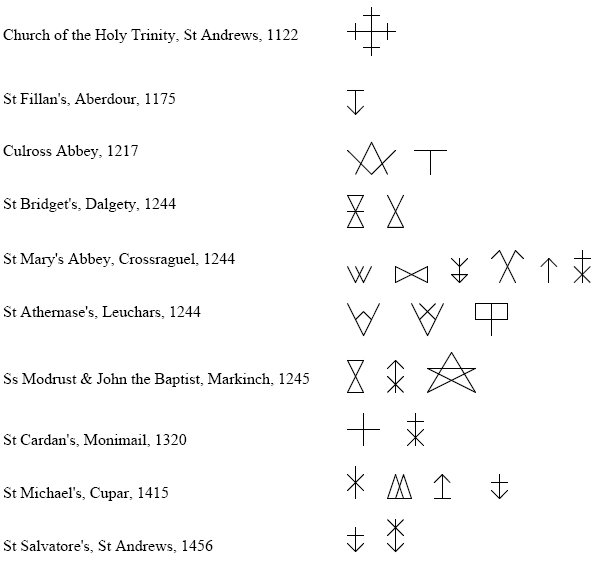
Bro A Abrahams, of Adelaide, visited
Edinburgh in 1851 and copied some 30 marks from stones of the underground walls
of Old Trinity Church, which was being demolished.[44]
This church was founded by Mary of Guelders, consort of James II (1430–1460).
The marks included:

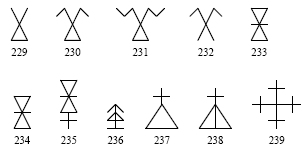
Bro Gould supplies an interesting but
undated set from Melgund Castle:
[45]
and Bro Bernard Jones an undated
collection from Melrose Abbey:[46]
Bro W I Macadam was a frequent
contributor of undated marks:[47]
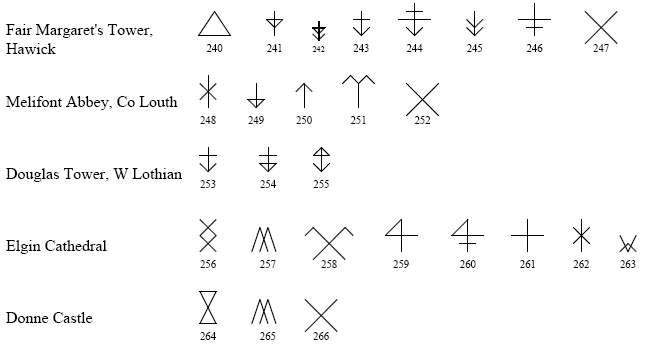
Let us now turn to the theories arising
from observation of masons' marks.
Symbolism
The symbolism attributed to masons'
marks is itself a vast field of study, one which, apart from a few general
comments, I must leave for another occasion.
Symbolic marks are by no means confined
to stones, as reference to any dictionary of symbolism, or examination of
medieval art, will readily disclose. Christianity adopted many symbols from
earlier times. Louisa Twining[48]
illustrates not only the familiar Latin, Greek and St Andrew's crosses as
symbols of Jesus, but also the tau and swastika. She provides several variations
of the chi rho monogram of Jesus[49]
(below), and an asterisk in a circle as an emblem of immortality. She
describes the triangle as a symbol of the Trinity, and comments that two
triangles combined (as a six-pointed star) was a favourite design in medieval
Christian art.

Bro Gould[50]
gives a short summary of the symbolism of the tau, swastika, five- and
six-pointed stars, the trident and the hourglass, and suggests that the figure 4
may often be an incomplete hourglass. To these we might add the asterisk and
S-shape as sun symbols, and the plain circle as a symbol of eternity.
It seems to me that a mason could well
adopt a religious or other symbol as a mark for work-related purposes, either
deliberately or unknowingly. From this I reason that where symbolic marks are
found in conjunction with non-symbolic marks, the symbolism is not relevant. If
the symbolic mark is isolated or in company only with other symbolic marks, the
symbolism may be germane. This emphasises the need for full notes to be supplied
with observations of marks.
Masons' marks have, of course, given us
an excuse to form another degree, and to ascribe moral teaching to some
of the more common marks.
Theories, notions and ideas
Bros Wynn Westcott and F F Schnitger
submitted to Ars Quatuor Coronatorum two theories based on the
cabbalistic writings of Heinrich Cornelius Agrippa von Nettesheim, relating to
secret alphabets and magical numbers. Bro Speth, the editor, chose a polite and
gentle way of setting the record straight, and added some useful information:
The above theory is ingenious, but I am
afraid untenable. I can only speak from a limited experience of marks,
practically confined to Canterbury Cathedral. There, at least, the same
marks recur over and over again in every part of the building … the well-known
hour-glass, for instance. The zigzag mark … is prominent beyond all others at
Canterbury, and, curiously enough, is seldom found alone on a stone, but
almost always in conjunction with some other mark, as if it were the countersign
of a foreman, or inspector …
My limited experience runs counter to
Bro. Hayter Lewis' suggestion that marks are seldom found on the plain wall
stones, but chiefly on carved work. At Canterbury the opposite is the case. In
the long north wall of the nave hardly a stone but has at least one mark,
besides usually the countermark already mentioned; but on the columns hardly a
mark is to be seen. On the south wall the marks are not quite so plentiful, but
I believe many of the stones in this wall have been turned, because the hoofs,
etc., of the horses at one time stabled along this wall had occasioned much
damage.
Bro Speth's reference to columns reminds
me that statues, when part of a group sculpted by different craftsmen, are often
marked in inconspicuous places, so that they can be correctly assembled.
Professor Rziha, who made a study of the
German Steinmetzen, theorised that a complex ‘master-diagram’ would have been
drawn of an intended large structure, and marks would be extracted from the
diagram and allotted to masons employed on the site. He claimed to have
recovered such diagrams from several European cities, to which Bro Poole[51]
comments:
It would be rash to deny the possibility
of such a system, however improbable (and unnecessary) it may appear. But it is
difficult to see how it could have applied in the case of the Scottish Mason,
whose Mark was allocated to him at the outset of his career, and could not be
substantially altered. For the same reason, it is not easy to see how it could
have been applied to the German stonemason … as the conditions seem to have been
similar.
Bro Poole further states:[52]
Among the Steinmetzen of Germany in the
seventeenth century, the Mason who was free of his apprenticeship and had
thereby attained the rank of Fellow Craft, was formally admitted into the
Fraternity at a regular Lodge meeting, when he took a solemn obligation to be a
true, loyal and obedient Mason and, among the avowals, he declared that he would
not of his own initiative change his distinctive mark. This was known as
“pledging his mark,” which, henceforth, became his distinctive property. The
mark was used by him as a signature, and he was required to engrave it upon all
his work on completion, but he was punished severely if he did so before his
work had been approved or passed. The placing of a mark upon finished work was
not, however, peculiar to stonemasons, but was the practice also of cutters and
joiners and, possibly, of other craftsmen. Nor was it a custom observed only in
Germany. It was certainly adhered to in France …
In Lodge Kilwinning, according to the
Minutes of December 20, 1678, two Apprentices were entered who “paid their
binding money and got their marks.”…
and earlier:[53]
The Schaw Statutes, which are
dated December 28, 1598, ordain that
no Master or Fellow-of-Craft is to be
received or admitted except in the presence of six Masters and two Entered
Apprentices, the Warden of the Lodge being one of the six, the date thereof
being orderly booked and his name and mark insert in the said book.
It seems clear from this that the
selection of a mark took place at the time when the Entered Apprentice became a
Fellow Craft.
Bro Poole cites other authorities, from
which he reasons:[54]
The conclusions which we may draw from
these references to the Scottish use of the Mark—and there seem to be no reasons
for supposing that English practice was different, or that they differed
materially from the practice of a much earlier age—are:
(i) that the Mason was allotted a Mark
of his own choosing;
(ii) at the time when he first became
qualified to accept work under a master;
(iii) and that he could not
alter his Mark except temporarily under special circumstances.
Some 19th-century observers claimed to
be able to distinguish indications of the class or grade of worker by the marks.
For example, V Didron divided French marks into those of overseers and workers.[55]
That this may be so in some cases is supported by the observation of Bro Speth
in Canterbury Cathedral. Two other students, E W Shaw (who intended to publish
a book, Historical Masonry, illustrated by 5,700 of the 11,000 marks he
had collected) and Smith,[56]
went further, claiming to distinguish between the marks of masters, fellow
crafts, apprentices, and unskilled labourers, so-called ‘blind’ marks. This is
difficult to accept, in view of the evidence that, except in special
circumstances, a mark was allocated to an individual for life.
In England and Scotland, at least, there
seems to be little evidence to support a further contention, that marks were
passed from father to son, or that a relative received basically the same mark
but with a small distinguishing feature. These practices may have occurred
occasionally, but were not widespread.
A group effort to collect marks
systematically in a small geographical area, such as that of Bro Rylands and
others in relation to Lancashire and Cheshire (illustrated earlier in this
paper), promises a much better opportunity to draw valid conclusions, in
relation to that area and timespan. Bro Poole[57]
cites further concerted efforts of this nature. In such circumstances the
recurrence of particular marks may well be significant, allowing the student to
trace a craftsman or group of masons as they moved from site to site.
With sparser information it is
impossible to attach significance to the duplication of a mark, especially when
the marks are widely separated geographically or temporally. As an extreme
example I refer to the triangle, figures 4 (Egypt, c 2500
bc), 21 (Crusader castle at
Sidon), 68 (Hindu temple), 120 (northern England, 1674), 157
(Holyrood Abbey, undated) and 240 (Scotland, undated). The only positive
deduction to be made is that the triangle is popular among masons as a mark, and
that is not surprising; it is aesthetically pleasing, has significance in the
construction of buildings, and is easy to carve. In fact, there is bound to be
duplication of marks, witting or unwitting, considering that the majority of
marks consist of less than 8 strokes, mostly straight lines.
I have numbered most of the marks in
this paper (and the others are readily identifiable) to facilitate further study
and discussion, although I anticipate that any serious student whose interest
has been aroused will refer to my sources—and find others.
Conclusion
Can one draw a conclusion? The very
magnitude of the subject seems to prevent this. The marks open many fascinating
lines of study and of speculation, as evidenced by the number of leading
researchers in Quatuor Coronati in the early days who included the marks as a
subject for study.
To me, the fact that the practice was
widespread indicates that their use had a strictly practical purpose. Building
is a severely practical pasttime; it does not devote time or energy to flights
of fancy. Therefore, my feeling is that when we get in-depth research on this
subject — and it will, of necessity, be conducted in the northern hemisphere —
the results will be quite prosaic.
I hope that in presenting this
preliminary study I have drawn the veil from an aspect of the Craft to which not
much attention has been given in recent years, and stimulated your interest. I
trust that you will judge that I have marked well.
[Editor's note: A condensed version of
this paper was presented to the conference. The very full endnotes are the
reason for the omission of a bibliography.]
Notes
[1] WOODFORD A F A: Kennings
Masonic Cyclopaedia, p458, London, George Kenning, 1878, quoted without
acknowledgement in GOULD R F: Concise History of Freemasonry, p239,
London, Gale & Polden, 1903.
[2] (1890) AQC III 65 @ 69.
[5] SIMPSON W, (1889) AQC II 124.
[6] SINGER I (ed): Jewish
Encyclopedia, vol 7 p123.
[8] Quarterly Statement (1889) Vol
1 p33, Palestine Exploration Fund.
[9] ‘The High Sanctuary of
Jerusalem’, Good Words, October 1881.
[10] A century of excavation in
Palestine, pp35,6, London, 1925, quoted in HORNE A: King Solomon's
Temple in the Masonic Tradition, p75, London, Aquarian Press, 1972.
[15] History of Freemasonry, 1st ed,
vol 1 p464, citing East of Jordan (1881).
[16] ‘Masonry and Masons' Marks’,
(1890) AQC III 65 @ 73.
[18] Masonic Record of Western
India, April 1890.
[19] see DYER C F W: The history
of the first 100 years of Quatuor Coronati Lodge No. 2076, p63, London,
QCCC Ltd, 1986.
[22] GOULD R F: ‘Collected essays
and papers on the antiquity of Masonic symbolism’, (1890) AQC III 130.
[23] GOULD R F: History of
Freemasonry, vol 1 pp455,6.
[24] The Freemasons' Guide and
Compendium, 1950.
[25] St CLAIR W K: ‘Degrees of Mark
Masonry’, Texas Grand Lodge Magazine, February 1946, reprinted in Chips
from the chisel, Holden Research Circle, Melbourne, 1992.
[26] Brewer's Dictionary of Phrase
and Fable, 14th ed p285, London, Cassel, 1990.
[35] Gould's History of
Freemasonry vol 1 ch 9.
[36] Freemasons' Guide and
Compendium p543.
[39] Mrs Murray Aynsley says: '…
the tradition regarding it is that when the true cross was found by the
Empress Helena, the footpiece was found displaced, therefore this form
was adopted and has ever since been retained by their communion.', 'The
Tau or Cross: a heathen and a Christian symbol', (1892) AQC V 84.
[40] Caementaria Hibernica,
Fasciculus primus 1726–1730, p10.
[41] Gould's History of
Freemasonry, vol 1 ch 9.
[43] ‘Degrees of Mark Masonry’, by
Bro Lt Col W K St Clair, February 1946.
[47] (1895) AQC VIII, 233; (1899)
AQC XII, 207.
[48] Symbols and Emblems of Early
and Mediaeval Christian Art, new edn, London, John Murray, 1885.
[50] Concise History of
Freemasonry, pp246-9.
[51] in his revision of Gould's
History of Freemasonry, 1951, vol 1 ch 7.
[55] GOULD R F: History of
Freemasonry, vol 1 pp455,6.
[56] Proceedings, Society of
Antiquaries of Scotland, vol iv p548.
|
![]() News Feed |
News Feed |  Subscribe News by Email
Subscribe News by Email